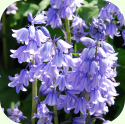Bellflowers
Different Bellflowers species vary significantly
in size and growing habitat.
Other Names: Campanula, Venus’ Looking
Glass, Harebell, Ladybell
Scientific Classification:
Kingdom: Plantae
Order: Asterales
Family: Campanulaceae
Genus: Campanula
|
|

Bellflower |
|
Descriptions: Bellflowers can have blossoms
that are tubular, bell, star, cup or saucer shaped.
Most species of bellflowers have a distinctive
bell-like shape.
Size: Bellflowers range from 5 centimeters
tall to 6 feet tall.
Symbolism: Bellflowers symbolize affection,
constancy and everlasting love. Bellflowers also
represent humility and delicacy. Bellflowers are
often given in gratitude to say "thank you".
Grow Details: Bellflowers vary in their
preferred habitat, it is best to refer to each
species for grow details.
Grow Details
Soil Type: Normal,
Sandy or Clay
Soil PH: Neutral, Alkaline or Acid
Water: Moist
Light: Sun to Part Shade
Grow Zone: 5, 6, 7, 8, 9
|
|
Characteristics
Height: Bellflowers range from 5
centimeters tall to 6 feet tall.
Flower Colors: Blue, Lavender, White,
Purple and Pink
Propagation: Propagate by division
or seed.
Division/Transplants: Divide in spring
or autumn. Take basal cuttings of perennials
in spring.
Blooming Period: Late Spring to Late
Summer
|
Type: Annual, Biennial and Perennial
Herbal Remedy Properties: In the past
Bellflowers were used to treat ear pain. Bellflower
roots were steeped and used for stomach aches.
Today bellflowers are said to aid in healing oral
inflammation, sore throats, heart and lung ailments,
as well as skin conditions.
Native Area: Campanulas are native to
the northern hemisphere.
Other: In Poland, people who were afflicted
with consumption were bathed in an infusion of
the bellflower. It was said, if the individual's
skin darkened after their bath, they would survive
and be healthy, on the other hand, if their skin
remained fair, they would die from the disease.
|
